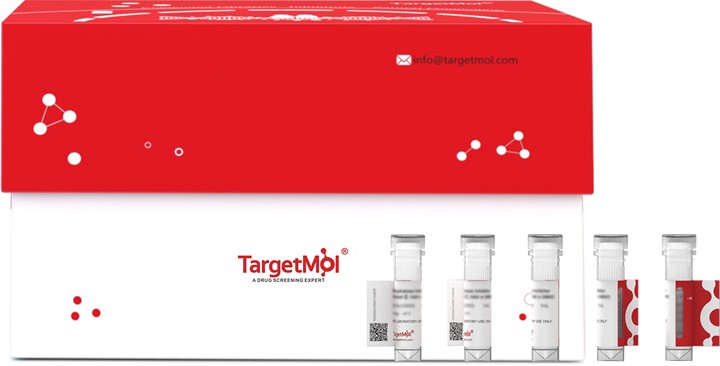 Your shopping cart is currently empty
Your shopping cart is currently empty
HO-1 Protein, Human, Recombinant
Heme Oxygenase 1 (HO-1) is an enzyme in endoplasmic reticulum that belongs to the heme oxygenase family. HO-1 cleaves the heme ring at the alpha methene bridge to form Biliverdin. Biliverdin is subsequently converted to Bilirubin by Biliverdin reductase. In physiological state, the highest activity of HO-1 is found in the spleen, where senescent erythrocytes are sequestrated and destroyed. HO-1 activity is highly inducible by its substrate heme and by various non-heme substances such as heavy metals, bromobenzene, endotoxin, oxidizing agents and UVA. HO-1 is involved in the regulation of cardiovascular function and response to a variety of stressors. Defects in HO-1 are the cause of Heme Oxygenase 1 deficiency, resulting in marked erythrocyte fragmentation and intravascular hemolysis, coagulation abnormalities, endothelial damage, and iron deposition in renal and hepatic tissues.

HO-1 Protein, Human, Recombinant
| Pack Size | Price | USA Warehouse | Global Warehouse | Quantity |
|---|---|---|---|---|
| 5 μg | $80 | 7-10 days | 7-10 days | |
| 10 μg | $129 | 7-10 days | 7-10 days | |
| 20 μg | $198 | 7-10 days | 7-10 days | |
| 50 μg | $390 | 7-10 days | 7-10 days | |
| 100 μg | $626 | 7-10 days | 7-10 days | |
| 200 μg | $987 | 7-10 days | 7-10 days | |
| 500 μg | $1,900 | 7-10 days | 7-10 days | |
| 1 mg | $2,730 | 7-10 days | 7-10 days |
Product Information
| Biological Activity | Activity has not been tested. It is theoretically active, but we cannot guarantee it. If you require protein activity, we recommend choosing the eukaryotic expression version first. |
| Description | Heme Oxygenase 1 (HO-1) is an enzyme in endoplasmic reticulum that belongs to the heme oxygenase family. HO-1 cleaves the heme ring at the alpha methene bridge to form Biliverdin. Biliverdin is subsequently converted to Bilirubin by Biliverdin reductase. In physiological state, the highest activity of HO-1 is found in the spleen, where senescent erythrocytes are sequestrated and destroyed. HO-1 activity is highly inducible by its substrate heme and by various non-heme substances such as heavy metals, bromobenzene, endotoxin, oxidizing agents and UVA. HO-1 is involved in the regulation of cardiovascular function and response to a variety of stressors. Defects in HO-1 are the cause of Heme Oxygenase 1 deficiency, resulting in marked erythrocyte fragmentation and intravascular hemolysis, coagulation abnormalities, endothelial damage, and iron deposition in renal and hepatic tissues. |
| Species | Human |
| Expression System | E. coli |
| Tag | Tag Free |
| Accession Number | P09601 |
| Synonyms | HO-1,HO1,HO,HMOX1,Heme Oxygenase 1 |
| Amino Acid | Met1-Thr261 |
| Construction | Met1-Thr261 |
| Protein Purity | Greater than 95% as determined by reducing SDS-PAGE. (QC verified) |
| Molecular Weight | 30 KDa (reducing condition) |
| Endotoxin | < 0.1 ng/µg (1 EU/µg) as determined by LAL test. |
| Formulation | Supplied as a 0.2 μm filtered solution of 20 mM PB, 150 mM NaCl, 1 mM EDTA, pH 7.4. |
| Stability & Storage | Lyophilized powders can be stably stored for over 12 months, while liquid products can be stored for 6-12 months at -80°C. For reconstituted protein solutions, the solution can be stored at -20°C to -80°C for at least 3 months. Please avoid multiple freeze-thaw cycles and store products in aliquots. |
| Shipping | Shipping with blue ice. |
| Research Background | Heme Oxygenase 1 (HO-1) is an enzyme in endoplasmic reticulum that belongs to the heme oxygenase family. HO-1 cleaves the heme ring at the alpha methene bridge to form Biliverdin. Biliverdin is subsequently converted to Bilirubin by Biliverdin reductase. In physiological state, the highest activity of HO-1 is found in the spleen, where senescent erythrocytes are sequestrated and destroyed. HO-1 activity is highly inducible by its substrate heme and by various non-heme substances such as heavy metals, bromobenzene, endotoxin, oxidizing agents and UVA. HO-1 is involved in the regulation of cardiovascular function and response to a variety of stressors. Defects in HO-1 are the cause of Heme Oxygenase 1 deficiency, resulting in marked erythrocyte fragmentation and intravascular hemolysis, coagulation abnormalities, endothelial damage, and iron deposition in renal and hepatic tissues. |
Dose Conversion
Calculator
Tech Support
| Size | Quantity | Unit Price | Amount | Operation |
|---|

Copyright © 2015-2025 TargetMol Chemicals Inc. All Rights Reserved.



